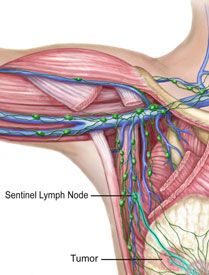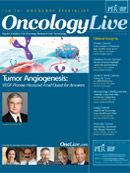Controversies in Treatment Spur Another Look at Z11
The Z11 study suggests that there is no difference in survival among patients with breast cancer who did not undergo a recommended surgical treatment.

For years, surgeons were taught that removing any and all cancerous tissue greatly reduced the risk of cancer recurrence. However, the notion that “to cut is to cure” is being challenged by a study that suggests that there is no difference in survival among patients with breast cancer who did not undergo a recommended surgical treatment.
The American Society of Clinical Oncology (ASCO) guidelines currently recommend that all cancerous lymph nodes be removed from under the arm in an effort to prevent the recurrence of cancer.
Before operating, a sentinel lymph node biopsy (SNB) is typically performed on patients with T1 or T2 breast cancer to determine whether any of the lymph nodes are cancerous. If no positive nodes are identified in the SNB, the chance of other lymph nodes being cancerous is very low, and only a sentinel lymph node dissection (SLND) is performed.
However, a positive sentinel node typically indicates a likelihood that other positive nodes exist, prompting an axillary lymph node dissection (ALND). This has been standard practice as reflected in the ASCO guidelines that currently state, “…the Panel recommends routine ALND for patients with a positive SNB on the basis of routine histopathologic examination.”
TABLE 1. Survival Outcomes of the Z11 Study
Median Follow-Up Years: 6.3
DFS
OS
SN
83.9 (80.2—87.9%)
92.5 (90—95.1%)
ALND
82.2 (78.3—86.3%)
91.8 (89.1-94.5%)
HR
0.82 (0.58—1.17)
0.79 (.56—1.1)
Adapted from Giuliano et al. JAMA. 2011;305(6):569-575.
ALND indicates axillary lymph node dissection; DFS, disease-free survival; HR, hazard ratio; OS, overall survival; SN, sentinel node.
A hotly debated study that was released in 2010 might eventually prompt changes to the ASCO guidelines. The American College of Surgeons Oncology Group (ACOSOG) Z11 randomized trial, published in the September 2010 issue of Annals of Surgery, found that survival rates were similar in patients with early-stage breast cancer with 1or 2 positive sentinel lymph nodes who underwent SLND and whole-breast irradiation (WBI) compared to those who underwent ALND with WBI (TABLE 1). These findings suggest that SLND without ALND could be a reasonable treatment option even in node-positive breast cancer patients. The median overall survival at 5 years was 91.8% in those who underwent ALND and 92.5% in those who were observed after SLND. Disease-free survival was 82.2% in patients with ALND and 83.9% in patients with SLND.

Monica Morrow, MD
“What that tells us is that axillary dissection is not necessary for local control and does not contribute to survival,” said Monica Morrow, MD, chief of Breast Service at Memorial Sloan- Kettering Cancer Center in New York City, who presented on Z11 at the 10th International Congress on the Future of Breast Cancer, held in August 2011 in Coronado, California.
“When you looked at disease-free survival or overall survival, there was also no statistically significant difference between the two groups,” said Morrow.
Morrow remarked on the unusually low recurrence rates among patients in the Z11 study (TABLE 2). Only 2 patients (0.5%) in the dissection arm (n = 420) and 4 patients (0.9%) in the sentinel-node-only arm (n = 436) experienced any kind of regional recurrence during a median follow-up of 6.3 years.
TABLE 2. Locoregional Recurrence in the Z11 Study
Median Follow-Up Years: 6.3
ALND
n = 420
SN
n = 436
Local
15 (3.6%)
8 (1.8%)
Regional
2 (0.5%)
4 (0.9%)
Total
17 (4.1%)
12 (2.8%)
P = .11
Giuliano et al. Ann Surg. 2010;252(3):426-433.
Morrow also pointed out the risks associated with performing ALND. In the Z11 study, 8% of patients who had ALND experienced some kind of wound infection, compared to 3% in the sentinel-node-only arm of the study. After 12 months, 39% of patients in the ALND arm experienced axillary parethesia, compared to 9% in the sentinel-node-only arm. Additionally, more patients in the ALND arm experienced symptoms of lymphedema than those in the sentinel-node-only arm.
Morrow acknowledges that the Z11 study has its critics. The study failed to meet its target accrual goal of 1900 patients, enrolling less than half that number. The study population was limited to early-stage, estrogen receptor- (ER) positive cases. The median age for patients treated with ALND and SLND was 56 and 54, respectively, and while reflective of these types of breast cancer cases, critics have said that younger patients should have been included in the study.
Despite these criticisms, Morrow, who is one of the authors of the Z11 study, said she believes that even if they performed the study again with more patients of different ages and genetic histories of breast cancer, the results would be the same.
Morrow believes the reason most critics do not support Z11 is because the results simply “don’t seem right,” as many surgeons feel that the “to cut is to cure” mantra should still apply.

Ultimately, Morrow said she considers the results of Z11 to be “practice changing.”
“At Memorial Sloan-Kettering, we have indeed changed our practice in agreement with our medical oncologists, and radiation oncologists’ recommendations to adopt this [approach] in treating patients with 1 or 2 involved sentinel lymph nodes who meet the other criteria (as defined in the Z11 study),” Morrow said.
However, there was additional discussion at the Future of Breast Cancer Congress, in which radiation oncologists pointed out that regional radiation therapy delivered to patients with nodepositive disease may aid a patient’s survival rate. Patients in the Z11 study had undergone wholebreast irradiation, even though the study was primarily focused on outcomes related to surgery.
Although the Z11 study found no difference in regional control, disease-free survival, or overall survival, another trial, NCIC-CTGMA20, found that patients who had ALND with regional nodal irradiation experienced a significant benefit in regional control, distant disease-free survival, and disease-free survival.
Some believe more information is needed before ASCO guidelines are changed in response to Z11, suggesting future studies include follow-up periods longer than 6.3 years, since 83% of patients in the Z11 study had estrogen-receptor disease that made these women more susceptible to later recurrence.




